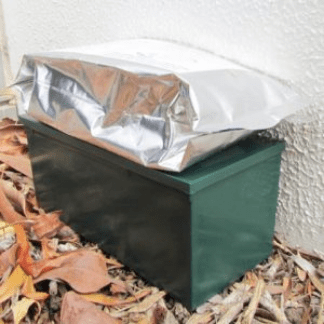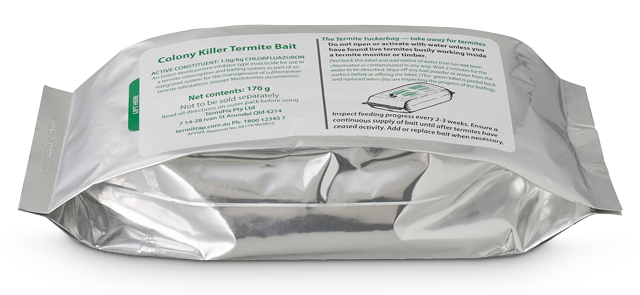Kill Termites with our Termite Baiting System

And… if you have questions along the way, chat with our team and they’ll share their knowledge to help you kill your termites.
Free Delivery to your door by Australia Post
A Termite Baiting System is the Most Effective and Reliable Termite Treatment and Defence Method in Use.
Because termite workers carry termite bait back to the nest to kill the whole colony
There are Two Ways to Bait Termites:
Directly to timber under termite attack.

Directly onto or into termite baiting stations that are under attack.

Worker termites cannot help but follow their instincts (evolution pattern):
- Termites search for wood
- Termites build a tunnel from their nest to the new wood source
- Termites chew off wood
- Termites take the wood back to feed the queen and all the young.
Our Colony Killer Termite Bait is based on alpha-cellulose, the main component of wood, but it is much easier to chew, swallow and regurgitate to feed their nestmates.
The active ingredient prevents the young termite nymphs from developing a new shell or exoskeleton, meaning they die instead of completing their next moult in growing bigger.
These simultaneous deaths mean there are too many bodies for disposal and toxic fungi grow on the corpses spreading to those living (including the reproductives)… and the whole termite colony dies.
This baiting system is much better than previous termite control methods.
Dusting the inside of timbers containing termite activity is always invasive and often disturbs them enough for them to vacate and bypass the treated area… which means they are no longer in contact with the poisonous dust. A few hundred may die but the colony survives.
For the 50+ years up until the millennium in 2000, the major focus was on termite prevention.
Thousands of litres of barrier treatment pesticides were hosed onto building sites to poison the soil under and around foundations.
There were at least three things wrong with barrier pesticides:
- Termites are able to find too many ways past the soil barriers (one way is enough).
- Such long-lasting chemicals concerned homeowners
- Most significantly… it didn’t kill the nearby termite colonies!
Think About this Last Point for a Moment.
Over 99.9% of colonies are situated outside buildings, so for around 50 years and in all the housing developments expanding from the cities and towns during that time, most termite colonies were not being killed!
Which of course increases the termite attacks on fences, sheds and other structures.
The major termite species threatening homes have a colony life of 30-50+ years.
They are all still out there, waiting, waiting, waiting for man-made or weather-made gaps in the pesticide barriers. A termite bait was what was really needed.
Back to Termite Baits:
Termite baiting stations are the most effective and reliable method of defending your home. Pest professionals switched over to it 20+ years ago and still favour it because it works best for them and homeowners.
Why? The wood inside the termite bait stations which are spread out around your home is easily accessed by scouting termites looking for a new food source… before they try the more difficult task of getting inside your home.
And, baiting termite activity you find inside any timber is the best way to kill the colony because termites take the bait, instead of wood, back as food for the colony… wherever it happens to be. You don’t need to know where the nest is because they do! You’ll know the colony is dead when no more termites are feeding in the bait station.
If you’ve found termites eating your house, shed or other structures, don’t disturb them until you order and receive your Colony Killer Termite Bait… then follow the illustrated instructions to make a small hole in the surface of the timber they are eating and attach the foil pouch of bait to it. Termites will pass directly from the timber into the more easily eaten bait and begin taking it, rather than chewed wood, back home. And that kills that colony!
If you want to defend your home from possible attack rather than waiting, hoping it won’t happen, when your TermiTraps arrive, follow the instructions or watch the video showing ideal places to place them around your home as sentries to intercept scouting termites… before they attempt the more difficult task of entering your home to find the timber up inside it.
Homeowners do not need to know anywhere near as much about termites as professionals because they have to become accredited to do business with you.
Ion Staunton, our entomologist, taught TAFE and wrote their textbooks.
All you need to know is simply explained in our practical and illustrated instructions that come with the Colony Killer Termite Baits… and if you are unsure, phone 1800 20 30 20 and talk to us… we are humans.
Additional Information
You can download our free How-to-Guide
Check out the rest of our website and shop
OR speak to a friendly, helpful human… 1800 20 30 20
OR click here to open a chat
Questions & Answers
Do Termite Baiting Systems Really Work?
When a Termite Baiting System is installed and regularly checked
A Termite Baiting System gives fantastic results in killing termite colonies as a professional pest controller.
How Long Does Termite Bait Stations Last?
Bait stations aka Termite Monitors or Termitraps, work for years waiting for termites to discover them
Termite bait does not have a shelf life
Once a colony begins feeding on the bait it can take a couple of months till total eradication
Can You Bait Termites Yourself?
Yes!
A DIY termite baiting system is the same method the professionals use
Homeowners can have the same success as professionals by taking the same steps
Regular checking and adding termite bait once termites are discovered.
How Fast do Termite Bait Stations Work?
Termite Monitors are ‘always’ ready for termites
Once termites show they arrive in the Termite Monitor termite baiting starts
The speed of termite baiting is dependent on the termites harvesting the termite bait.
But typical results (total termite colony eradication) are seen within approx 3 months.
Why Do Termite Bait Stations Work Safely?
Since baiting by professionals became the go-to method of killing termite colonies around 1999-2000, there are fewer sensational stories simply because placing bait stations around home results in the death of nearby termite colonies before the termites actually get up inside a home to begin eating it.
Killing termites and preventing termite attacks has been a professional-only job for over a hundred years. The chemicals have not been readily available to homeowners. In 2002 a friend asked me how he could check his backyard for termites between the annual visits by the pest professional. As I’d taught the subject in TAFE and had written the textbooks currently in use, he expected me to work out a homeowner way. I designed a station with its highest priority to be attractive to scouting termites from any nearby nest and secondly, it had to have a fool-proof way to indicate termites had discovered the station without the owner having to open, disturb and frighten off the termites inside.
Next, I had to Nationally register a bait leaving off the usual wording “For sale to and use by registered pest technicians only”. The strength and formulation are exactly the same as those used by the pros and registration was granted because its label does not require the heading POISON or even CAUTION. If your dog actually ate a full bag of bait (unlikely because it is so tasteless) it would be just pricey dog food.
With my knowledge and teaching experience, I knew I could explain to homeowners the simple processes of killing termites found attacking timber and also how to entice termites into these baiting stations before they found their way into buildings… just like the professionals. Kits have been sold to more than ten thousand homeowners since 2003.
How Does Termite Bait Kill Colonies?
Termites are arthropods with an outer shell. Think prawns, crabs and lobsters for a moment; they are also arthropods but everyone recognises that their shell has to be removed to get to eat the soft and tasty bits. You might also know that for all arthropods to grow bigger toward maturity, they need to shed the shell that has become too tight. They stop eating/ moving for a few days, grow a new softshell under the current shell then expand themselves (a bit like The Hulk) and bust off the old shell, holding their breath for an hour or so until the new, bigger and pliable shell hardens… then carry on eating and growing toward the next moult toward maturity.
The bait causes a malfunction. There are thousands upon thousands of termite nymphs in the actual nest being fed by workers regurgitating partly digested wood brought back from the feeding areas. When the bait is placed in or on timber, it becomes the preferred food to be transferred back simply because it is so much easier to chew off a bellyful of moist particles than solid wood. All termite baits contain a substance that prevents the nymph from producing a new shell (chitin). As arthropods are the target of this chitin-inhibiting chemical and the only arthropod with access to the substance is the termite, you can see how non-hazardous this method is. When all those nymphs in the central nest are dying instead of moulting, the ‘housekeeping’ cannot cope with all the corpses; decomposition gases and entomopathogenic fungi spread into the adjacent royal chamber… and that colony does not recover.
Some bogus claims are made:
The chemical weakens and softens the exoskeleton or “outer shell” and Softens the termite mandibles, which results in the termite being unable to chew timber
Wrong. It just prevents the production of new chitin at moulting time.
How do Termite Baiting Stations or Termite Monitors Defend Your Home?
Placing termite stations around buildings can prevent infestation of those structures by intercepting and scouting termites trying to find another food source. Why does this work?
Australian homes, for more than 50 years, have had to be constructed with improving levels of physical barriers to make termites cross exposed areas by building visible access tunnels. Think about galvanised metal ant caps placed on top of piers or stumps (they’ve been in use for a hundred years). It made termites build out and around these caps, if they wanted to get up to the flooring timbers. Since we began pouring concrete slabs for floors, drainage or other services access had to be sealed using collars to prevent gaps from appearing as the concrete shrank. And the edge of the slab had to remain visible so that if termites built their mud tunnels up over the edge it could be easily noticed. All this also makes it difficult for scouting termites to get up inside a house to find a timber framework.
Why do termites scout for timber?
A nest is first begun when two flying termites from an early summer evening swarm find a suitable situation meeting the combination of two necessities: moisture and wood. They also need to be able to quickly secure themselves against or under this moist wood; ants, lizards or birds will find and eat the pair soon after daylight if they are too slow. After securing the new nest site, they mate and tend the first batch of hatching nymphs until they finally have a few dozen adult workers to take over the nursery and food-gathering duties. At this stage they may be able to move the ‘palace’ a small distance deeper but, a lot of things can go wrong. The original moisture may only have been from a shower of rain and the soil dries out. Without access to a new moisture source close by or just a bit deeper… the incipient colony dies. If the food was just a small piece of wood and it is washed away or someone picks it up or it is otherwise moved… the food source is gone and they all die from a combination of no food and exposure to drying out. You can see why we are not overrun by termites.
The colony that manages to survive the critical first year or so is one that found reasonably substantial wood and a continuing moisture source. But if the food supply is running low, workers that have done most of the jobs in the colony and are approaching their “use-by date” are selected to leave the active workings to find a new food source and report back. On warmer, and humid evenings, some of these workers leave and walk above ground level to find wood, preferably a big piece, determined by chewing on it and recognising its substance by the acoustics from their chew with their jaws. They are also guided to nearby wood by sensing increased levels of carbon dioxide that come from bacteria in wood that is also under partial decay.
Just occasionally, a worker finds such wood but then has to get back to the colony to report it. We do not know that process but we do know that when other social insects such as ants and bees find a new food (or a tree in bloom) on getting back to the nest/hive they convey the destination information. On other occasions, termites searching for a better/closer moisture source burrow through soil and may come across condensation under a concrete slab. And concrete slabs are usually adjacent to a building. There may even be some wooden formwork that wasn’t removed as a bonus!
Now you know the process of termites searching for new food, you can understand how stations containing desirable wood, set roughly 3 metres apart around structures, particularly in areas conducive to termite requirements, are easily found by a scouting termite and why it meets their requirements without them having to go the extra distance to the building, then find a way into it, then find timber, then find its way back out again… and finally report back to “the committee”.
As nests are almost never started within a building, your home is under constant threat from any nearby nest. When the nest finds and begins getting its food from a Monitoring or Baiting Station and, as a homeowner, you notice that the Station is under attack because the hole in the lid is blocked by them to prevent loss of humidity and the entrance of ants, you simply add bait and let them do what it is instinctive for them to do. They self-destruct because they are doing exactly what they have always done for eons of time… when there were no buildings, only fallen logs and branches.
What is the Main Difference Between Homeowners and Professionals?
Price. The professional has to pay about the same for the bait and for the stations as you… but you don’t have the overheads of running a business. You work for free and you don’t need to travel.
Sure you don’t know as much about termites as technicians but you know enough to add bait to timbers containing termites and to monitors or stations that have been found by termites where you’ve placed them around your home. We provide illustrated instructions in every carton of product and we answer the phone. Talk to one of our team about your situation and get a simple, easily understood answer to things you don’t quite understand. Free call 1800 20 30 20 in business hours.


